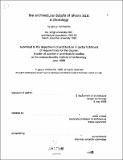| dc.description.abstract | A chorology is an analysis of the relationships between the constituent parts of a system or assemblage. Architecture is not only the result of the connection between a vast set of components and their manifold interactions, it is implanted into still broader, working fields of complex affiliations and relations. Essential to understanding the importance of Alvaro Siza's' buildings is to see his architecture as assemblages comprised of many composite, active subsystems. These assemblages engage still larger systems, dynamic and effects producing. In short, the architecture goes beyond the visual, and generates effects in time and space - engaging animate operations that pre-exist the architecture while inciting multiple new dynamic relations. The architecture must be seen as a machine, testing the line between natural and manmade. Not necessarily organic, but self organized, exhibiting the characteristics of self generating systems, or in other words, life. While a conventional architectural analysis might exhaustively diagram geometric relations, or try to find historical models or precedents to situate the work, this thesis seeks to be critical of the deterministic, historical practice of naming. Instead, opting for a perhaps discursive methodology, which endeavors to understand operative modes that compose the abstract machinic-architectural assemblages of Alvaro Siza. As a beginning to understanding the complex assemblages of Siza, this thesis will specifically examine architectural details, their interrelationships, and affiliations to materials and techniques of construction. Details will be considered as constituent parts of a larger assemblage, and as engaging dynamic criteria (forces, light, program, weather, time, etc.) as a means of conditioning space. By considering the effects which conspire to compose a detail, in conjunction with the effects that are generated, a new understanding of the immeasurable complexity of an architectural assemblage and its' relations to space might be understood. Affording criteria for testing performance, inciting possibilities for new terms of responsiveness in architectural assemblages, and offering new, germane modes of making. this chorology will examine the affiliative assemblages of the Boa Nova Tea House at Leca da Palmeira, Portugal from 1958 and the teachers training college at Setubal, Portugal from 1994. The thesis will carefully examine conditioning agents and effects of detail assemblages, their relationships to operative criteria, other details, and space. instrumental texts include those by Deleuze and Guattari, Fernando Pessoa, and Peter Testa. | en_US |
